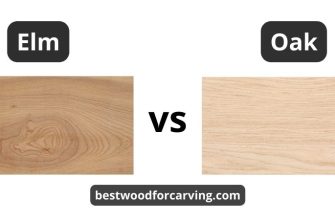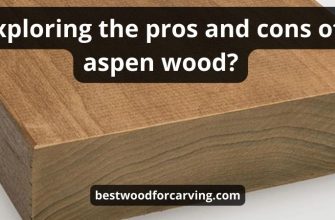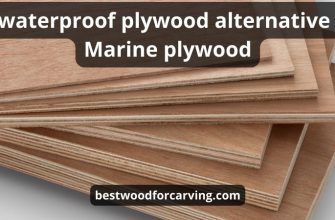Tung oil and polyurethane are both very popular in the world of carpentry and woodwork, though both are remarkable wood finishes, but how well do they compare with each other, find out in this article as I explore “Tung oil vs Polyurethane”.
![Tung oil vs polyurethane [4 main comparison factors] tung oil vs polyurethane](https://bestwoodforcarving.com/wp-content/uploads/2023/12/aidcoffeemaker-12.jpg)
- Tung oil: overview
- Features
- Disadvantages
- Polyurethane: overview
- Features
- Disadvantages
- Tung oil vs polyurethane
- Durability
- Appearance
- Cost
- Application
- Which is the better choice?
- FAQ
- What are the disadvantages of tung oil?
- Should I polyurethane over tung oil?
- Is oil better than polyurethane?
- Is Minwax tung oil finish waterproof?
- Is tung oil the best finish?
- Conclusion
Tung oil: overview
Tung oil, or “China wood oil,” is made from tung tree seeds. About 50–65% of the oil in the seeds is extracted using solvent extraction techniques.
The oil’s distinctive qualities, such as its capacity to polymerize and create a protective layer on a wood surface or wood floors, are attributed to its abundance of unsaturated fatty acids.
When applied to wood, tung oil deeply penetrates the wooden surface, enhancing the wood’s natural color and grain while creating a warm and sleek finish.
This characteristic makes it a preferred choice if you’re seeking to enhance the inherent beauty of the wood.
The drying time of tung oil is comparatively slower than that of most finishes. When exposed to air, it polymerizes and gradually cures to form a hard surface.
Several coats are frequently applied to obtain the appropriate degree of protection and gloss
While not entirely waterproof, tung oil is moderately water resistant, making it suitable for indoor and outdoor applications.
![Tung oil vs polyurethane [4 main comparison factors] aidcoffeemaker 13](https://bestwoodforcarving.com/wp-content/uploads/2023/12/aidcoffeemaker-13.jpg)
Features
Penetration. Tung oil deeply penetrates wooden surfaces, highlighting the natural grain, texture, and color of the wood. This attribute of tung oil makes it a favorite among people seeking to showcase the inherent beauty of different wood types.
Cool finish. After application, the tung oil finish leaves the wood with a smooth, glossy finish that highlights its natural beauty. It preserves the authenticity of the wood while giving off a warm, welcoming appearance without giving off a glossy sheen.
Polymerization. Tung oil undergoes a slow polymerization process upon exposure to air, gradually curing to form a durable surface contributing to its long-lasting protective qualities.
Non-toxic. Another important feature of tung oil is its non-toxic nature making it perfect for several for culinary furniture such as a kitchen table or cutting boards.
Disadvantages
Drying Time. Each coat of tung oil needs substantial time to dry thoroughly before applying subsequent coats, prolonging the finishing process.
Application Process. Tung oil finish requires multiple coats for optimal protection and a desired finish, which can be time-consuming and labor-intensive.
![Tung oil vs polyurethane [4 main comparison factors] aidcoffeemaker 15](https://bestwoodforcarving.com/wp-content/uploads/2023/12/aidcoffeemaker-15.jpg)
Polyurethane: overview
Polyurethane is a polymer composed of organic units joined by urethane bonds.
The adaptable structure of polyurethane, which enables countless applications due to its adjustable properties, is based on this chemical reaction.
Rigid foams of polyurethane are used in construction, insulation, refrigeration, and flotation devices while flexible foams are used in upholstery, bedding, car seats, and packaging.
Both water-based polyurethane and their oil-based counterpart are applied using various methods such as spraying, pouring, brushing, or dipping, depending on the intended use.
Proper wood surface preparation and application techniques are crucial for achieving optimal performance and durability.
![Tung oil vs polyurethane [4 main comparison factors] aidcoffeemaker 16](https://bestwoodforcarving.com/wp-content/uploads/2023/12/aidcoffeemaker-16.jpg)
Features
Weather resistance. Its resistance to a wide range of solvents, oils, and chemicals makes it more appropriate for use in harsh environments, this excellent weather resistance is exhibited by both oil-based poly and water-based polyurethane.
Insulation. Polyurethane reduces heat transfer and improves energy efficiency in buildings, appliances, and refrigeration systems making it an excellent thermal insulator.
Strength. Oil-based polyurethane is capable of supporting significant loads without deformation or structural failure, making it valuable in countless applications.
Disadvantages
Appearance. Oil-based polyurethane tends to leave a thick patina behind and create a glossy or plastic-like finish, which might not preserve the natural look and feel of the wood surface effectively unlike tung oil finishes.
Brittleness. Rigid forms of polyurethane can be brittle, especially in extreme temperatures, leading to cracking or chipping over time.
![Tung oil vs polyurethane [4 main comparison factors] aidcoffeemaker 17](https://bestwoodforcarving.com/wp-content/uploads/2023/12/aidcoffeemaker-17.jpg)
Tung oil vs polyurethane
Both tung oil and polyurethane are amazing finishes, but they have certain distinctions and excel differently in certain aspects, these aspects are explained below.
Durability
Durability is an important feature to consider while comparing tung oil versus polyurethane, tung oil offers moderate protection against scratches and can resist dirt.
Although it can strengthen the wood’s inherent resilience, more frequent reapplication may be necessary for long-lasting protection.
Polyurethane is considered more durable because of its resilient and long-lasting protective qualities.
Polyurethane excels in providing a robust shield against wear, scratches, and moisture.
Its highly durable finish maintains its integrity for an extended period making it perfect for hardwood floors.
![Tung oil vs polyurethane [4 main comparison factors] aidcoffeemaker 18](https://bestwoodforcarving.com/wp-content/uploads/2023/12/aidcoffeemaker-18.jpg)
Appearance
Pure tung oil brings out the natural beauty of the wooden surface, offering a warm finish that accentuates the wood grain without creating a glossy sheen.
A tung oil finish is a better choice if you want a warm, natural look that highlights the qualities of the wood.
Oil-based polyurethane finishes typically create a glossy or plastic-like appearance, providing a uniform sheen that may hide the natural beauty of wooden surfaces.
If a glossy, consistent finish is desired, oil-based polyurethane is the better choice, but it doesn’t preserve the natural look of wood as effectively as tung oil.
![Tung oil vs polyurethane [4 main comparison factors] aidcoffeemaker 19](https://bestwoodforcarving.com/wp-content/uploads/2023/12/aidcoffeemaker-19.jpg)
Cost
Tung oil can be relatively more expensive, especially higher-quality, pure tung oil or raw tung oil.
Its coverage, however, may differ, which would change the final cost.
The need for multiple coats and periodic reapplication will make tung oil more costly in the long run.
Both water-based poly and oil-based poly are more affordable and widely available in different price ranges
![Tung oil vs polyurethane [4 main comparison factors] aidcoffeemaker 20](https://bestwoodforcarving.com/wp-content/uploads/2023/12/aidcoffeemaker-20.jpg)
Application
Applying tung oil requires patience and skill. It needs multiple coats with adequate drying time between each layer.
Polyurethane tends to be easier to apply, requiring just a couple of coats and offering faster drying times, making it more user-friendly, especially for beginners.
Which is the better choice?
The ultimate choice between tung oil and polyurethane depends on your specific preferences.
Tung oil is better if you’re willing to invest time in a more labor-intensive application process and periodic maintenance while polyurethane is a better choice if you prefer a glossy or consistent finish.
![Tung oil vs polyurethane [4 main comparison factors] aidcoffeemaker 21](https://bestwoodforcarving.com/wp-content/uploads/2023/12/aidcoffeemaker-21.jpg)
FAQ
What are the disadvantages of tung oil?
While tung oil offers deep penetration and amazing water resistance it equally comes with several disadvantages, these disadvantages include a stressful application process and a longer drying time.
Should I polyurethane over tung oil?
You should choose polyurethane varnish over tung oil if you prefer durability and a more affordable option.
Is oil better than polyurethane?
Tung oil is considered better than polyurethane in some aspects, including durability and water resistance.
Is Minwax tung oil finish waterproof?
Yes, being a safe beautiful, and water-proof finish is one of the many notable advantages of Minwax tung oil over other finishes.
Is tung oil the best finish?
Yes, tung oil is widely considered the best finish due to its water-resistant nature and its beautiful appearance.
Conclusion
Tung oil offers an aesthetically pleasing option that highlights the natural beauty of wood while polyurethane provides a long-lasting finish suitable for high-traffic surfaces and diverse environments.
Your ultimate choice depends on the nature of your wood projects and your personal preferences.

![Tung oil vs polyurethane [4 main comparison factors] Tung Oil Vs Polyurethane: Top 4 Factors & Best Helpful Guide](https://bestwoodforcarving.com/wp-content/uploads/2023/12/wood-14-870x400.jpg)
![Sapele vs. walnut wood [5 main differences] Sapele Vs. Walnut Wood: Top 5 Differences & Best Guide](https://bestwoodforcarving.com/wp-content/uploads/2024/01/wood-53-335x220.jpg)
![Mango wood furniture pros and cons [9 tips] Mango wood furniture pros and cons + 9 tips before you buy](https://bestwoodforcarving.com/wp-content/uploads/2024/01/wood-51-335x220.jpg)

![Which advantages and disadvantages of hickory wood? [8 factors] Top 8 Disadvantages Of Hickory Wood: Best Helpful Guide](https://bestwoodforcarving.com/wp-content/uploads/2024/01/wood-38-335x220.jpg)


![How Long Do Wood Pellets Last? [6 Essential Insights Unveiled] How long do wood pellets last](https://bestwoodforcarving.com/wp-content/uploads/2023/12/How-Long-Do-Wood-Pellets-Last-6-Essential-Insights-Unveiled-2-335x220.jpg)
![Is tung oil flammable? [7 Preventive measures] Is Tung Oil Flammable: Top 7 Safe Tips & Best Guide](https://bestwoodforcarving.com/wp-content/uploads/2023/12/What-is-a-Wood-Planer-3-335x220.jpg)
